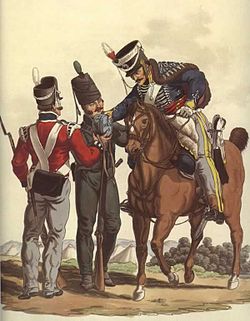King's German Legion
| King's German Legion | |
|---|---|

Members of the King's German Legion
|
|
| Active | 1803–16 |
| Country | Electorate of Hanover; since 1814 Kingdom of Hanover |
| Branch | British Army |
| Type | Legion of mixed troops: cavalry, infantry, and artillery. |
| Size | approximately 14,000 |
| Garrison/HQ |
Infantry at Bexhill-on-Sea Cavalry at Weymouth, Dorset |
| Battle honours |
|
| Commanders | |
| Notable commanders |
Eberhardt Otto George von Bock |
Infantry at Bexhill-on-Sea
The King's German Legion (KGL) was a British Army unit of mostly expatriate German personnel during the period 1803–16. The Legion achieved the distinction of being the only German force to fight without interruption against the French during the Napoleonic Wars.
The Legion was formed within months of the dissolution of the Electorate of Hanover in 1803, and constituted as a mixed corps by the end of 1803. Although The Legion never fought autonomously and remained a part of the British Army during the Napoleonic Wars (1804–15), it played a vital role in several campaigns, most notably the Walcheren Campaign, the Peninsular War, and the Hundred Days (1815).
The Legion was disbanded in 1816. Several of the units were incorporated into the army of the Kingdom of Hanover, and became later a part of the Imperial German Army after unification in 1871.
The British German Legion, recruited for the Crimean War, is sometimes erroneously referred to as the "King's German Legion".
After the occupation of Hanover by Napoleonic troops the Convention of Artlenburg, also called the Convention of the Elbe, was signed on 5 July 1803 and formally dissolved the Electorate of Hanover. Consequently, the Elector's army was disbanded. Many former Hanoverian officers and soldiers fled the French occupation of Hanover to Britain; George III, the deposed Elector of Hanover, was also King of the United Kingdom. The same year, Major Colin Halkett and Colonel Johann Friedrich von der Decken were issued warrants to raise a corps of light infantry, to be named "The King's German Regiment". On 19 December 1803, Halkett's and von der Decken's levies were combined as a basis of a mixed corps (includes all arms: mounted, infantry, artillery) renamed the King's German Legion. The KGL infantry were quartered in Bexhill-on-Sea and the cavalry in Weymouth, Dorset. Some units were involved in a street fight in Tullamore, Ireland with a British Light infantry unit in the so-called Battle of Tullamore. The number of Officers and Other Ranks grew over time to approximately 14,000, but during the 13 years of its existence, close to 28,000 men served in the Legion at one time or another. Initially, most of the officers were appointed with temporary rank, but in 1812 all the officers of the Legion were given permanent rank in the British Army for 'having so frequently distinguished themselves against the enemy.' It saw active service as an integral part of the British Army from 1805–1816, after which its units were disbanded.
...
Wikipedia
